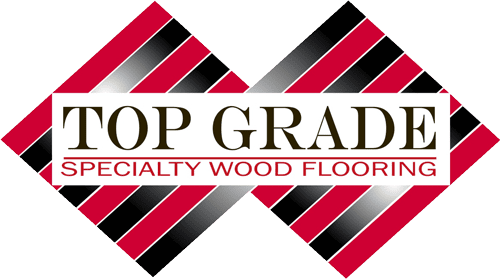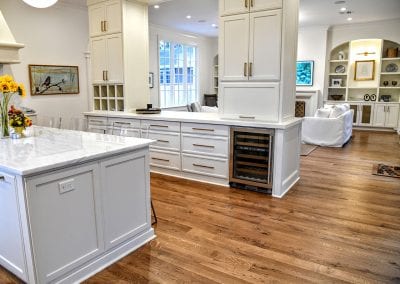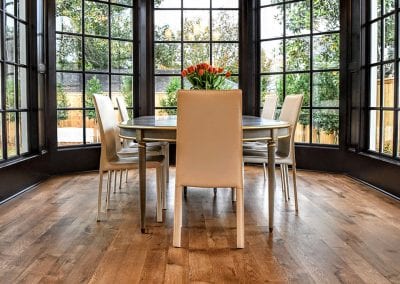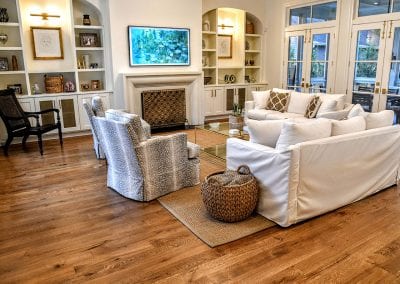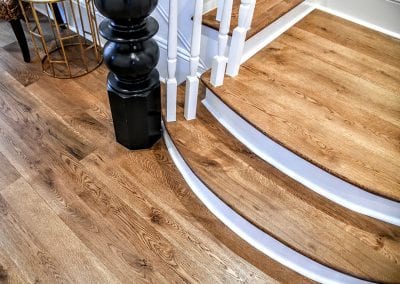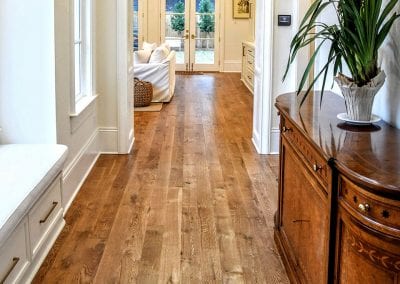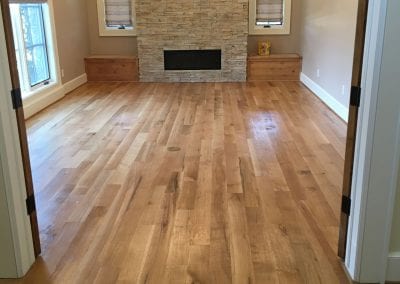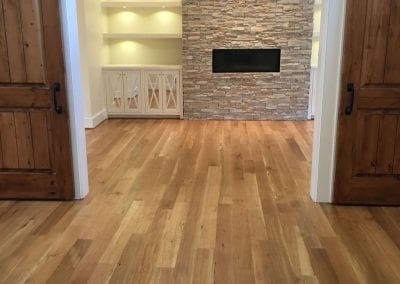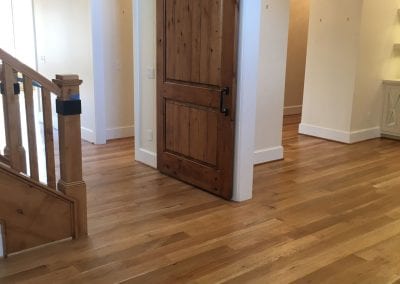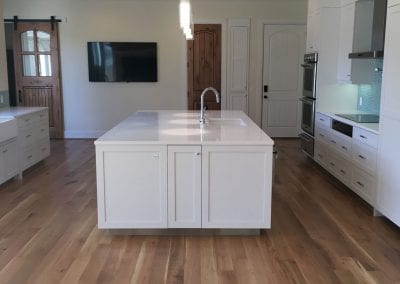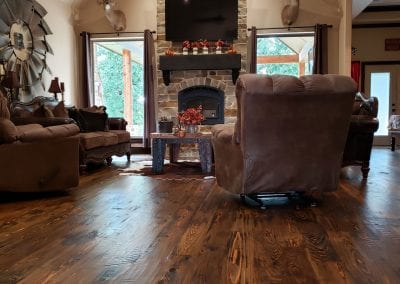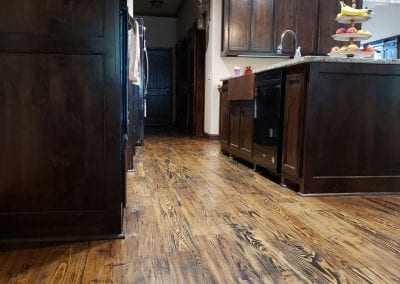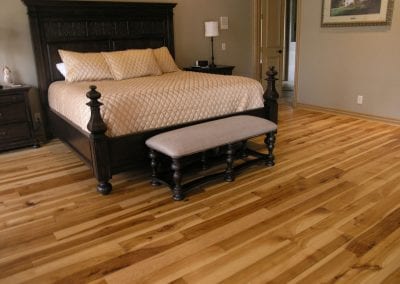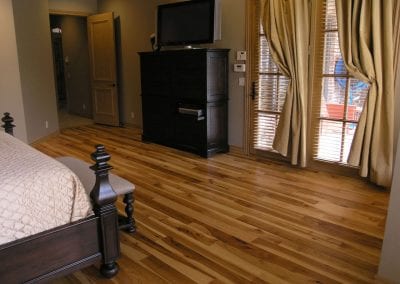Domestics
When talking about domestic hardwood flooring, species like oak, hickory, and maple are sure to come up in conversation. However, other species like cherry, birch, and walnut are just as popular with contemporary builders and designers. Domestic hardwood floors are attractive, give off a warm appearance, and are very affordable. The color of most domestic hardwoods is a bit more understated than exotics. Traditional species also tend to match better with most modern kitchens and home furnishings.
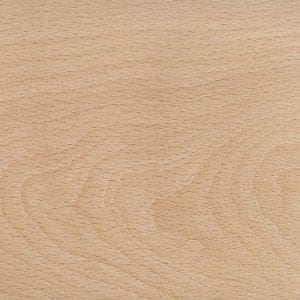
American Beech
American Beech is sometimes underrated and under-appreciated: which may be due to its somewhat bland appearance. Yet considering its decent strength and hardness—and its comparatively low cost—Beech represents an excellent value for woodworkers.
Also known as Fragus grandifolia
Specifications
Cuts: Plainsawn and Rift & Quartered
Widths: 2 1/4″, 3″, 3 1/4″, 4″, 4 1/4″ 5″, 5 1/4″ and custom widths.
Color Properties: Beech is typically a pale cream color, sometimes with a pink or brown hue. Veneer tends to be slightly darker colored, as slicing the veneer usually requires the wood to be prepared with steam, which gives the wood a more golden tone. Flatsawn surfaces tend to be very plain, while quartersawn surfaces exhibit a silvery fleck pattern.
Packaging: Packed in nested bundles or like length bundles
Finish: Material is supplied unfinished
Grades: Clear Grade, Select & Better, #1 Common, Rustic / Character Grade
Hardness: 1300 lbs.
Stability: 11.9
Working Properties: Overall good workability; it machines well, and glues, finishes, and turns well. Beech also responds superbly to steam-bending. It does, however, have a large amount of movement in service, so movement and wood stability must be taken into account.
Family: Fagaceae
Origin: Eastern United States
The wood photographs on this website cannot accurately represent actual color or appearance of the wood due to the differences in the way monitors render images.
References:
2004 National Wood Flooring Association “Wood Species Used In Wood Flooring”, Revised Edition
“The Wood Database” content used with permission.
“Tropical Timbers of the World”, Forest Products Lab, Madison, WI, 1984
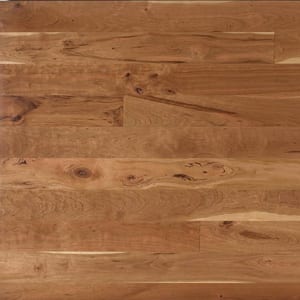
American Cherry
American Cherry is a strong but moderately hard wood. It is rich in color with a fine satin texture. American Cherry is extremely light sensitive, meaning the color usually darkens over a short period of time when exposed to light.
Also known as North American Cherry, Black Cherry, Cherry, Prunus Serotina
Specifications
Cuts: Plainsawn and Quartersawn
Widths: 2 1/4″, 3″, 3 1/4″, 4″, 4 1/4″ 5″, and 5 1/4″, or Custom Widths
Color Properties: Heartwood can range from a light to dark reddish brown. Sapwood can be a light pale brown with light pinkish tones.
Texture: The texture is uniformed and frequently wavy, with distinctive gum veins and pockets.
Packaging: Packed in nested bundles or like length bundles
Finish: Unfinished and Prefinished
Grades: Clear Grade, Select & Better, #1 Common, Rustic / Character Grade
Hardness: 950
Stability: 7.1
Working Properties: Good machining qualities
Family: Rosaceae
Origin: North America
The wood photographs on this website cannot accurately represent actual color or appearance of the wood due to the differences in the way monitors render images.
References:
2004 National Wood Flooring Association “Wood Species Used In Wood Flooring”, Revised Edition
“The Wood Database” content used with permission.
“Tropical Timbers of the World”, Forest Products Lab, Madison, WI, 1984
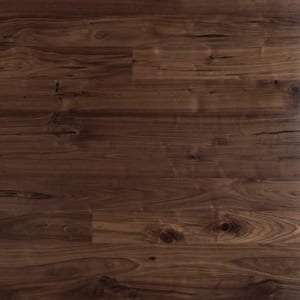
American Walnut
Walnut is one of the most durable of the domestic commercial woods. The wood is heavy, hard, and stiff and has excellent dimensional stability. The wood often has a purplish cast with dark streaks. The grain of walnut is mostly straight and open, though some boards may have a grain pattern that is burled or curly.
American Walnut, Eastern Black Walnut, American Black Walnut, Eastern Walnut, Northern American Walnut, Black Walnut and Juglans Nigra.
Specifications
Cuts: Plainsawn and Quartersawn
Widths: 2 1/4″, 3″, 3 1/4″, 4″, 4 1/4″ 5″, 5 1/4″ and custom widths.
Color Properties: Sapwood is nearly white, heartwood ranges in color from a deep, rich dark, almost chocolate brown to a purplish black. The wood often has a purplish cast with dark streaks.
Packaging: Packed in nested bundles and like length bundles
Finish: Material is supplied unfinished and prefinished.
Grades: Clear Grade, Select & Better, #1 Common, Rustic / Character Grade
Hardness: 1010
Stability: 7.8
Working Properties: Excellent machining qualities
Family: Juglandaceae
Origin: North America
The wood photographs on this website cannot accurately represent actual color or appearance of the wood due to the differences in the way monitors render images.
References:
2004 National Wood Flooring Association “Wood Species Used In Wood Flooring”, Revised Edition
“The Wood Database” content used with permission.
“Tropical Timbers of the World”, Forest Products Lab, Madison, WI, 1984
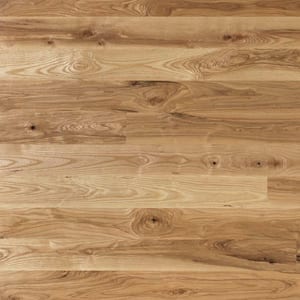
Ash
Limited supply due to the Emerald Ash Borer
Ash, American Ash. You can expect colors from bright tan to tannish brown with mineral, sound knots, and a full assortment of grain and texture that make this wood so beautiful. This wood offers great potential for creative design. Hardwood floors and paneling are not only beautiful they are easy to care for. Ash has a very comfortable feel and blends well with most furnishings. Other features include increased stability, durability, and an assortment of sizes make the possibilities endless.
Also known as Canadian Ash, White Ash or Fraxinus Americana
Specifications
Widths: 2-1/4”, 3″, 4″ and 5″ or custom widths.
Color Properties: Bright tan to tannish brown with mineral, sound knots, and a full assortment of grain and texture.
Texture: Bold, straight, moderately open grain with occasional wavy figuring. Can have strong contrast in grain in plainsawn.
Packaging: Packaged in nested bundles or like lengths
Finish: Unfinished or Prefinished
Grades: Clear Grade, Select & Better, #1 Common, Rustic / Character Grade
Hardness: 1320
Stability: 7.8
Working Properties: Good machining qualities
Family: Oleaceae
Origin: North America
The wood photographs on this website cannot accurately represent actual color or appearance of the wood due to the differences in the way monitors render images.
References:
2004 National Wood Flooring Association “Wood Species Used In Wood Flooring”, Revised Edition
“The Wood Database” content used with permission.
“Tropical Timbers of the World”, Forest Products Lab, Madison, WI, 1984
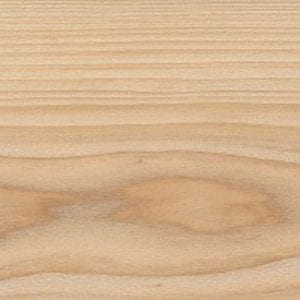
Cypress
Baldcypress is the state tree of Louisiana, and is an icon of southern swamplands. So named because the trees are deciduous (unlike most conifers), and have the peculiar trait of dropping all their needle-like leaves each the winter. The trees also develop unique aerial roots that protrude above the ground (or water) and are especially seen on trees growing in swamps. These structures are known as knees, and are sometimes harvested on a small scale and sold for woodcarving purposes. Although not technically a cypress in the strictest sense (Cupressus genus), Baldcypress is in the Cupressaceæ family, which includes many decay resistant woods (including cedars), and the wood is a popular choice in exterior construction applications where decay resistance is needed.
Cypress, Baldcypress, Taxodium distichum
Specifications
Widths: Custom widths.
Color Properties: Color tends to be a light, yellowish brown. Sapwood is nearly white. Some boards can have scattered pockets of darker wood that have been attacked by fungi, which is sometimes called pecky cypress.
Packaging: Like length bundles
Finish: Material is supplied unfinished.
Grades: Rustic / Character Grade, Millrun
Hardness: 510
Stability: 6.2
Working Properties: Sharp cutters and light passes are recommended when working with Cypress to avoid tearout. Also, the wood has been reported by some sources to have a moderate dulling effect on cutting edges. Cypress has good gluing, nailing, finishing, and paint-holding properties.
Family: Cupressaceæ
Origin: Southeastern United States
The wood photographs on this website cannot accurately represent actual color or appearance of the wood due to the differences in the way monitors render images.
References:
2004 National Wood Flooring Association “Wood Species Used In Wood Flooring”, Revised Edition
“The Wood Database” content used with permission.
“Tropical Timbers of the World”, Forest Products Lab, Madison, WI, 1984
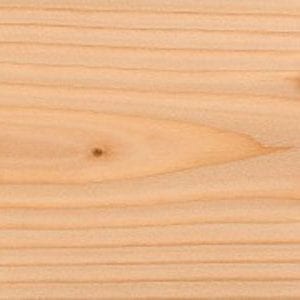
Douglas Fir
Douglas Fir
Named after Scottish botanist David Douglas, (though the scientific name is in honor of Archibald Menzies, who first described the tree in the 1790s). Douglas-Fir is technically not a true Fir (Abies genus), but is in its own genus: Pseudotsuga. The tree itself grows to be very large, and yields a large amount of usable lumber and veneer for plywood. It is an incredibly valuable commercial timber, widely used in construction and building purposes. The wood is very stiff and strong for its weight, and is also among the hardest.
Pseudotsuga menziesii
Specifications
Widths: 2 1/4″, 3″, 3 1/4″, 4″, 4 1/4″ 5″, 5 1/4″ and custom widths.
Color Properties: Can vary in color based upon age and location of tree. Usually a light brown color with a hint of red and/or yellow, with darker growth rings. In quartersawn pieces, the grain is typically straight and plain. In flatsawn pieces, (typically seen in rotary-sliced veneers), the wood can exhibit wild grain patterns.
Packaging: Packed in like length bundles
Finish: Material is supplied unfinished
Grades: Douglas Fir has grades similar to pine species, for grading questions please contact us for clarification
Hardness: 620
Stability: 7.3
Working Properties: Typically machines well, but has a moderate blunting effect on cutters. Accepts stains, glues, and finishes well.
Family: Pinaceae
Origin: Western North America
The wood photographs on this website cannot accurately represent actual color or appearance of the wood due to the differences in the way monitors render images.
References:
2004 National Wood Flooring Association “Wood Species Used In Wood Flooring”, Revised Edition
“The Wood Database” content used with permission.
“Tropical Timbers of the World”, Forest Products Lab, Madison, WI, 1984
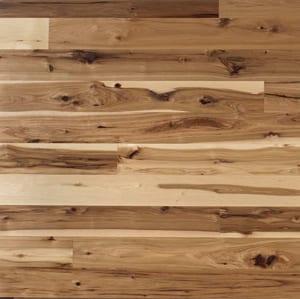
Hickory
Hickory is one of the hardest of the indigenous wood species. It is about 40% harder than oak. Hickory is not normally produced as a single wood species. Hickory is often a mixture of pignut, shagbark, pecan and bitternut hickory. Hickory Wood has an eye-catching appeal because of its dramatic appearance in the grain. Hickory’s high density and resilient surface will stand up to many years of wear.
Pecan, American Hickory and Carya ssp
Specifications
Cuts: Plainsawn and Quartersawn
Widths: 2 1/4″, 3″, 3 1/4″, 4″, 4 1/4″ 5″, and 5 1/4″ or custom widths.
Color Properties: Heartwood is a reddish brown with dark brown strips. Sapwood is often white with pinkish tones.
Packaging: Packed in nested bundles or like length bundles
Finish: Material may be supplied unfinished and prefinished.
Grades: Select & Better, #1 Common, Rustic / Character Grade
Hardness: 1820
Stability: 8.9
Working Properties: Hickory’s density makes it difficult to machine and work with hand tools
Family: Juglandeae
Origin: North America
The wood photographs on this website cannot accurately represent actual color or appearance of the wood due to the differences in the way monitors render images.
References:
2004 National Wood Flooring Association “Wood Species Used In Wood Flooring”, Revised Edition
“The Wood Database” content used with permission.
“Tropical Timbers of the World”, Forest Products Lab, Madison, WI, 1984
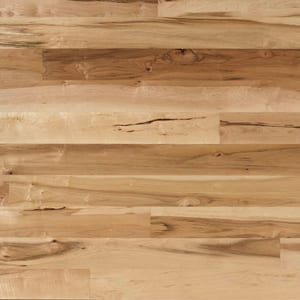
Maple
Maple is notably resistant to abrasive wear; and for this reason, it is the hardwood flooring of choice for such high-traffic/hard-use locations as bowling alleys, basketball courts, and other sports facilities. This wood has a closed, subdued grain and a uniform texture, with medium figuring. The figuring is variously described as quilted, curly, “bird’s-eye,” and “fiddleback.” During the grading process, interestingly figured boards are often culled from the group and sold at a premium.
Hard Maple, Sugar Maple, Black Maple, Bird’s Eye Maple, and Acer Saccharum
Specifications
Cuts: Plainsawn and Edge Grain (Quartersawn)
Widths: 2 1/4″, 3″, 3 1/4″, 4″, 4 1/4″ 5″, 5 1/4″ or custom widths.
Color Properties: Heartwood ranges from creamy white to light reddish brown. Sapwood is a creamy white.
Packaging: Packed in nested bundles or like length bundles
Finish: Material is supplied unfinished and prefinished.
Grades: Clear Grade, Select & Better, #1 Common, Rustic / Character Grade
Hardness: 1450
Stability: 9.9
Working Properties: Density makes machining difficult
Family: Sapindaceae
Origin: North America
The wood photographs on this website cannot accurately represent actual color or appearance of the wood due to the differences in the way monitors render images.
References:
2004 National Wood Flooring Association “Wood Species Used In Wood Flooring”, Revised Edition
“The Wood Database” content used with permission.
“Tropical Timbers of the World”, Forest Products Lab, Madison, WI, 1984
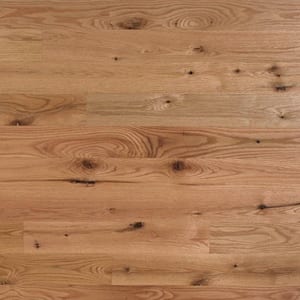
Red Oak
Red Oak
There are more than 200 subspecies of Red Oak in North America. There is a great variation in color and grain depending on the origin of the wood and differences in growing seasons. The grain of red oak is more open and somewhat coarser than white oak.
Northern Red Oak, Canadian Red Oak, Maine Red Oak, Southern Red Oak, Black Oak, Gray Oak, Eastern Red Oak, Appalachian Red Oak, and Quercus Rubra
Specifications
Cuts: Plainsawn, Riftsawn, Quartersawn, Rift & Quartered, or Livesawn
Widths: 2 1/4″, 3″, 3 1/4″, 4″, 4 1/4″ 5″, 5 1/4″ and custom widths.
Color Properties: Heartwood is a light to medium brown, commonly with a reddish cast. Nearly white to light brown sapwood is not always sharply demarcated from the heartwood. Quartersawn sections display prominent ray fleck patterns. Conversely, white oak tends to be slightly more olive-colored, but is by no means a reliable method of determining the type of oak. Heartwood and sapwood are similar in appearance, which is light-colored with a reddish tone.
Packaging: Packed in nested bundles or like length bundles
Finish: Material is supplied unfinished and prefinished.
Grades: Clear Grade, Select & Better, #1 Common, Rustic / Character Grade
Hardness: Northern average 1290, Southern average 1060
Stability: Northern average 8.6, Southern average 11.3
Working Properties: Above average in all machining operations
Family: Fagaceae
Origin: North America
The wood photographs on this website cannot accurately represent actual color or appearance of the wood due to the differences in the way monitors render images.
References:
2004 National Wood Flooring Association “Wood Species Used In Wood Flooring”, Revised Edition
“The Wood Database” content used with permission.
“Tropical Timbers of the World”, Forest Products Lab, Madison, WI, 1984
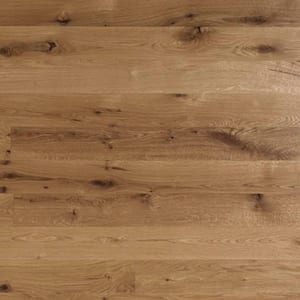
White Oak
White Oak is slightly harder than red oak and also is more durable. It has a high shock resistance and resists wear. Open grain with longer rays than red oak. Plainsawn boards have a plumed or flared grain appearance, riftsawn has a tighter grain pattern, low figuring, Quartersawn has a flake pattern, sometimes called tiger rays or butterflies.
American White Oak, Rock Oak, Basket Oak, Swamp Oak, Chestnut Oak, Cow Oak and Quercus Alba
Specifications
Cuts: Plainsawn, Riftsawn, Quartersawn, Rift & Quartered, or Livesawn
Widths: 2 1/4″, 3″, 3 1/4″, 4″, 4 1/4″ 5″, and 5 1/4″ widths or custom wider widths
Color Properties: Heartwood is light to medium brown, commonly with an olive cast. Nearly white to light brown sapwood is not always sharply demarcated from the heartwood. Quartersawn sections display prominent ray fleck patterns. Conversely, red oak tends to be slightly redder, but is by no means a reliable method of determining the type of oak.
Packaging: Packaged in nested bundles or like length bundles
Finish: Material is supplied unfinished and prefinished.
Grades: Clear Grade, Select & Better, #1 Common, Rustic / Character Grade
Hardness: 1360
Stability: 10.05
Working Properties: Excellent machining qualities
Family: Fagaceae
Origin: North America
The wood photographs on this website cannot accurately represent actual color or appearance of the wood due to the differences in the way monitors render images.
References:
2004 National Wood Flooring Association “Wood Species Used In Wood Flooring”, Revised Edition
“The Wood Database” content used with permission.
“Tropical Timbers of the World”, Forest Products Lab, Madison, WI, 1984
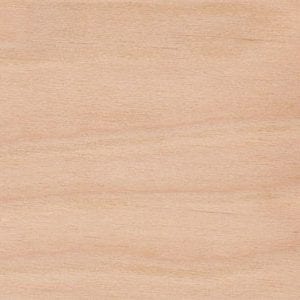
Yellow Birch
Birch is one of the most widely used woods for veneer and plywood worldwide. Besides regular sheets of plywood, Birch veneer is also used for doors, furniture, and paneling.
Yellow birch, Paper birch, Silver birch, Sweet birch, Alder leaf birch, Gray birch, Betula alleghaniensis
Specifications
Cuts: Plainsawn
Widths: 2 1/4″, 3″, 3 1/4″, 4″, 4 1/4″ 5″, 5 1/4″ and custom widths.
Color Properties: Heartwood tends to be a light reddish brown, with nearly white sapwood. Occasionally figured pieces are available with a wide, shallow curl similar to the curl found in Cherry. There is virtually no color distinction between annual growth rings, giving Birch a somewhat dull, uniform appearance. “Red birch” is not a separate species but the heartwood of birch selected for reddish color.
Packaging: Packed in nested bundles or like length bundles
Finish: Material is supplied unfinished and prefinished.
Grades: Clear Grade, Select & Better, #1 Common, Rustic / Character Grade
Hardness: 1260 lbs.
Stability: 9.5
Working Properties: Generally easy to work with hand and machine tools, though boards with wild grain can cause grain tearout during machining operations. Turns, glues, and finishes well.
Family: Betulaceae
Origin: Northeastern United States
The wood photographs on this website cannot accurately represent actual color or appearance of the wood due to the differences in the way monitors render images.
References:
2004 National Wood Flooring Association “Wood Species Used In Wood Flooring”, Revised Edition
“The Wood Database” content used with permission.
“Tropical Timbers of the World”, Forest Products Lab, Madison, WI, 1984
Get in Touch
American hardwoods give beauty and value to any property. What questions can we address about these lovely woods?
